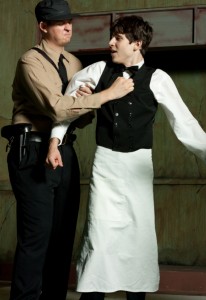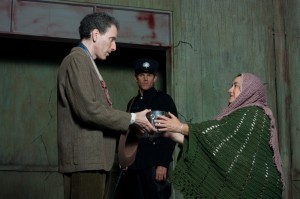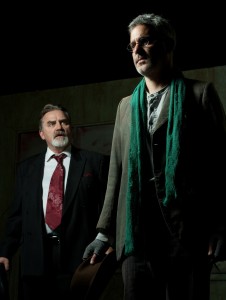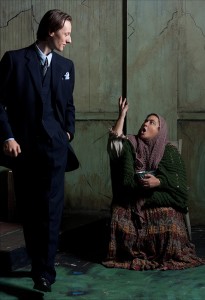
The mind still boggles and the heart still recoils at the statistics. Nearly 6,000,000 Jews killed, including 90% of the Polish Jewish population, 90% of German and Austrian Jews, and similarly high percentages in the Baltics and Czechoslovakia. If Jews in France fared “better,” with 74% their 350,000 surviving the Holocaust, these figures provided cold comfort to the 90,000 exterminated by the Nazis.
Arthur Miller puts a personal face on a dozen or so of these French victims of Nazi terrorism in his powerful Incident At Vichy, now being revived at the Sierra Madre Playhouse in a proscenium-staged production that comes close to matching what you’d see at the Pasadena Playhouse or any major regional theater, albeit on a smaller scale.
Director Barbara Schofield opens the play precisely as Miller describes it, the lights going up on a drably painted, sparsely furnished detention room where we see five men, a gypsy woman, and a young boy “frozen there like members of a small orchestra at the moment before they begin to play,” looking something like a cross between a Millet painting and one by Edward Hopper.
We soon learn that the seven have been picked up off the streets of the capital of the ironically dubbed État Français, the puppet “French State” run by French collaborators like Marshal Philippe Pétain. One by one, we get to know each of these individuals as they fearfully await what they presume will be a check of their papers to determine if any of them have fled to Vichy from the German-occupied northern half of France; in other words, who among them are Jews.
They are painter Lebeau (Barry Saltzman), a nervous, unkempt sort with a tendency to prattle; electrician Bayard (Rendon Ramsey), who tries to calm down the painter with an “It’s no need getting excited. We’ll find out soon.”; businessman Marchand (John Dimitri), aloof and seemingly unconcerned because “with so many strangers pouring into Vichy this past year there’re probably a lot of spies and God knows what. It’s just a document check, that’s all.”; actor Monceau (Colin Campbell), who agrees with Marchand that “Vichy must be full of counterfeit papers” and that “as soon as they start, it shouldn’t take long.”; a gypsy (Rebecca Rodick), holding a metal pot and explaining in broken French (which we hear as English) that she was attempting to fix the pot when “come police. Pfft.”; a teenaged waiter (Zayd Jaber), who recognizes one of their captors, a German major he serves breakfast to each morning, “really not a bad fellow. Regular army, see, not one of these S.S. bums.”; and a silent boy (Andy Scott Harris) of fourteen or so.
 Before long, new detainees are ushered in by a French captain (Brent Schindele): an elderly Jew (Vance Wells), a doctor named Leduc (Richard Michael Knolla), and Austrian prince Von Berg (David Kieran).
Before long, new detainees are ushered in by a French captain (Brent Schindele): an elderly Jew (Vance Wells), a doctor named Leduc (Richard Michael Knolla), and Austrian prince Von Berg (David Kieran).
Overseeing the proceedings is a German professor (Karyn O’Bryant), whose “Next!” soon becomes the most frightening word each of the assembled detainees has ever heard, one likely to lead to a fate they hope against hope will not be as grim as the one their worst fears conjure up.
These fears are hardly assuaged when Bayard informs them that only yesterday, a fellow railroad worker heard human voices from inside a thirty-car freight train emitting “a stench that could be smelled a hundred yards away, babies crying inside, and women too,” the boxcars’ doors locked from the outside, the train engineer’s Polish nationality implying a destination far from Vichy, France. The gypsy’s presence among them is hardly reassuring, since as Bayard points out, “they’re in the same category of the Racial Laws.”
If the detainees feel somewhat encouraged when Marchand, the first to be interviewed, is allowed to exit, a white paper pass in his hands, they soon discover that his departure may well be the first and last, as their numbers begin to dwindle in a horrific real-life version of And Then There Were None.
If Incident At Vichy were no more than the suspense drama described above, it would already have much to recommend in it as a piece of theater. Since it is an Arthur Miller play, it offers an audience much, much more.
 Over the course of Incident At Vichy’s intermissionless ninety-minutes, the Pulitzer Prize-winning playwright gives us glimpses into each of these characters’ hearts and souls, as each expresses his feelings regarding their detainment. Lebeau agonizes over knowing that he could have left France in 1939, but stuck around when his mother refused to leave their furniture behind. Bayard recommends solidarity among the detainees, and suggests a way they might manage to escape from one of those locked boxcars. Leduc urges the others to unite and take action against their captors, a suggestion his fellow detainees seem apathetic about at best. Monceau simply refuses to believe in rumors of Nazi death camps with extermination ovens. And Von Berg, an Austrian Catholic, seems to be the only one of them likely to be let go.
Over the course of Incident At Vichy’s intermissionless ninety-minutes, the Pulitzer Prize-winning playwright gives us glimpses into each of these characters’ hearts and souls, as each expresses his feelings regarding their detainment. Lebeau agonizes over knowing that he could have left France in 1939, but stuck around when his mother refused to leave their furniture behind. Bayard recommends solidarity among the detainees, and suggests a way they might manage to escape from one of those locked boxcars. Leduc urges the others to unite and take action against their captors, a suggestion his fellow detainees seem apathetic about at best. Monceau simply refuses to believe in rumors of Nazi death camps with extermination ovens. And Von Berg, an Austrian Catholic, seems to be the only one of them likely to be let go.
With its grim subject matter, it’s perhaps no wonder that Incident At Vichy lasted only thirty-two performances in its original Broadway run. This was, after all, less than two decades after the end of World War II revealed Nazi atrocities to the world.
Still, grim or not, Incident At Vichy must be seen, not only for the power of Miller’s writing and the play’s further development of themes explored in All My Sons and The Crucible, and not only for Schofield’s expert direction and the outstanding work being done by her cast, but because of its continuing relevance in the year 2012, a case of “now, more than ever.”
Simply put, Incident At Vichy is the finest production I have seen at the Sierra Madre Playhouse.
Performances could hardly be better. Saltzman’s dithery, high-strung painter and Ramsey’s rebellious yet philosophical electrician are both superb, as are Knolla and Kieran, whose powerful final confrontation recalls that of Chris and Joe Keller, though under quite different circumstances. Campbell stands out as a thespian whose steadfast refusal to believe the worst of the Nazis may spell his doom, with Dimitri, Harris, Jaber, and Wells equally memorable in smaller roles. Matt Dodge’s German major starts off rather wooden, but catches fire in the character’s electric confrontation with Knolla’s Leduc. Schindele and Aaron Michael Jackson as café proprietor Ferrand do well too in their brief appearances. Finally, there are Rodick and O’Bryant in the two roles director Schofield has recast as women to powerful effect. Rodick makes an indellible impression in her brief scenes as a time and life-ravaged gypsy, and as for the sensational O’Bryant, the stone cold face and heart of evil have never been more terrifying.
There’s a stark beauty to the detention room set designed by Schofield and Don Bergmann, especially as lit by Sammy Ross, at the top of her craft, and decorated (if that word can be applied here) by Anne Marie Atwan’s excellent props. Barry Schwam’s sound design sets a dramatic, suspenseful mood from the get-go, with Shon LeBlanc’s costumes about as period and character perfect as they come.
Jade Cagalawan is stage manager, Michael Tamblyn assistant stage manager, and Grace Korkunis assistant stage manager intern.
No longer content to fill its seasons with British sex farces and comedy mystery chestnuts, the Sierra Madre Playhouse deserves major kudos for challenging its audiences with edgy, thought-provoking, adult fare like Arthur Miller’s Incident At Vichy (and applause for singling out the many members of Actors Equity among the cast of characters). Eminently deserving of the frequent revivals granted Miller’s better known works, Incident At Vichy is must-see theater, and well worth the drive to Sierra Madre, quite possibly the L.A. area’s most picturesque “small town.” Trust me. You will not regret any extra miles you put on your gas tank.
Sierra Madre Playhouse, 87 W. Sierra Madre Blvd., Sierra Madre.
www.sierramadreplayhouse.org
–Steven Stanley
July 27, 2012
Photos: Michael Sirota




 Since 2007, Steven Stanley's StageSceneLA.com has spotlighted the best in Southern California theater via reviews, interviews, and its annual StageSceneLA Scenies.
Since 2007, Steven Stanley's StageSceneLA.com has spotlighted the best in Southern California theater via reviews, interviews, and its annual StageSceneLA Scenies.







 COPYRIGHT 2025 STEVEN STANLEY :: DESIGN BY
COPYRIGHT 2025 STEVEN STANLEY :: DESIGN BY